Take Home Messages
Introduction
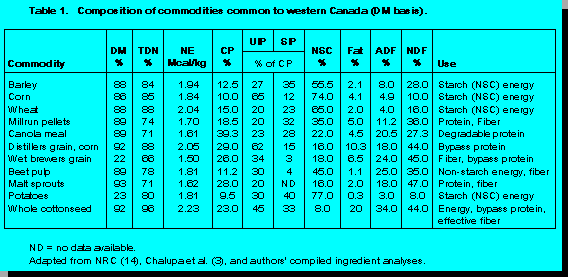
This paper will focus on commodities that are commonly available to dairy producers in western Canada (Table 1), it is not meant to be an extensive review. The feed value and care with which each commodity should be fed will be discussed. An economic assessment of commodity feeding versus more traditional feeding will also be presented.
Major Commodities
It's no secret, western Canadian dairy concentrates are built on barley and canola meal. In this part of the world, these typically are the least expensive sources of energy and degradable intake protein (DIP), respectively. In the Pacific Northwest (B.C., Washington, Oregon), most of the barley fed is purchased directly as a steam rolled-product. In the prairies, more of the barley is dry-rolled on-farm. This is likely because it's either grown directly by a producer or is readily accessible. Which is better for dairy cows, steam- rolled or dry-rolled barley?
A review by Huntingdon (9) indicates that steam-rolled is superior to dry-rolled barley in terms of rumen fermentability (5 percentage units), starch digestion in the small intestine (15 percentage units), and whole tract digestibility (5 percentage units). Increased rumen starch fermentation is conducive to greater microbial protein output still the major source of protein for the lactating dairy cow. Improved whole tract digestibility agrees with the common field observation of less undigested grain in the manure with steam-rolled over dry-rolled barley. Unlike corn or sorghum however, trials with feedlot cattle have failed to show significant improvement in animal growth rate or feed efficiency with steam-rolled barley over dry-rolled barley (4, 5, 13). Theurer (18) reported a 3.2 kg improvement in milk production and a 0.13% unit increase in milk protein with steam-flaked versus dry- rolled sorghum. However, there is no published work comparing steam-rolled versus dry- rolled barley for lactating dairy cows. The real advantage to steam-flaked over dry-rolled or hammer milled barley probably lies in: (1) the pre-requisite for feed manufacturers to consistently use a heavier weight barley (i.e. more starch), and (2) less fines. The benefit of less fines is that fewer liver abscesses have been seen in feedlot cattle fed steam- rolled over dry-rolled barley, likely because of larger particle size (4, 5). Could the same feature benefit the dairy cow in terms of improved butter fat and less laminitis? Despite the nutritional advantages of steam-rolled over dry-rolled barley, the lack of information demonstrating improved performance and a $15 to $25/tonne premium for the product, make it a "hard sell". The reader is referred to further discussion on the true cost of on- farm processed barley in the section entitled, Economics of Commodity Feeding.
Apart from normal ration balancing restraints (e.g. ensuring adequate forage fiber) there are no limitations to the use of barley in dairy rations. At times, its starch degradation rate in the rumen may also be a factor to consider in determining the amount of barley fed.
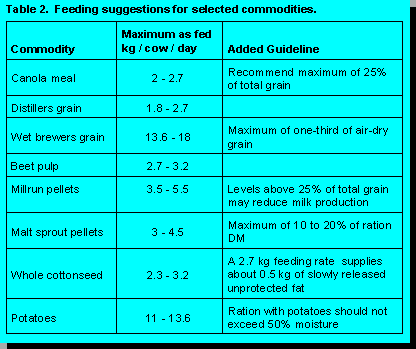 Canola meal is typically not used at levels
in excess of 25% of the concentrate (2). This allows for as much as 4 kg as-fed (AF)/cow/day.
Nevertheless, there is wisdom in blending different vegetable and animal proteins for a superior
amino acid profile post- ruminally. Therefore, to safeguard against one concentrate being relied
upon too heavily, I would not recommend canola meal be fed at levels in excess of 2 to 2.7
kg/cow/day (Table 2).
Canola meal is typically not used at levels
in excess of 25% of the concentrate (2). This allows for as much as 4 kg as-fed (AF)/cow/day.
Nevertheless, there is wisdom in blending different vegetable and animal proteins for a superior
amino acid profile post- ruminally. Therefore, to safeguard against one concentrate being relied
upon too heavily, I would not recommend canola meal be fed at levels in excess of 2 to 2.7
kg/cow/day (Table 2).
Distillers Grains
Corn, rye, and wheat distillers are highly palatable sources of high bypass protein (Table 1). They are all similar in nutrient profile, although my experience is that corn distillers is somewhat more palatable. Research has established that distillers grains contain yeast by-products that stimulate rumen cellulose digestion (8). Hutjens (10) suggests distillers grains be limited to a maximum of 1.8 to 2.7 kg/cow/day. The manufacturing of distillers grains includes heating and drying, so when buying large quantities, it is wise to determine how much of the crude protein (CP) is heat damaged and therefore less available as indicated by acid detergent insoluble nitrogen (ADIN) analysis. In general, the darker the color, the greater the heating.
Wet Brewers Grain
In western Canada, wet brewer's grain ("brew") typically sells for $33 to $37/m . A cubic meter is about 815 kg. This translates to $36 to $41/wet tonne and $135 to $154/air dry (90% DM) per tonne.
Brew has approximately three-quarters the energy of barley, but approximately two times its value in protein (Table 1). Brew's advantage lies in it's palatability and as an economical source of bypass protein. It's disadvantage is that it is a product that is 70 to 80% water and therefore very susceptible to spoilage. Brew should be fed out within five to six days in cool weather and two to three days in hot weather to minimize feed deterioration and subsequent rumen upset (7).
As a high moisture feed, it's use should be limited in a ration heavily based on silages. A 0.17 kg decrease in DMI/day for every 1% increase in diet moisture over 50% has been reported (14). The upper limit for feeding brew is 13.6 to 18 kg (12) or one-third of the air- dry grain. Brew is low in soluble protein and potassium, so ensure rations are balanced for these nutrients when it is fed. Poor milk production and/or reduced fertility caused by spoiled brew or excess brew to fresh cows, have often been observed. Furthermore, if one takes into account the difference in weight between what is bought and what is fed the difference being in seepage and spoilage, 15% shrink can be added to determine its true cost as a feed commodity (6). I have seen as much as 25% shrink for brew on a farm where it is routinely fed. Providing brew is fed: (1) without spoilage and not at excess levels, and (2) with adjustment every two to three days to a diminishing moisture (i.e. seepage), it will work well. This generally requires a large dairy located near a brewery.
Beet Pulp
Beet pulp is a by-product in the manufacturing of sugar from sugar beets. It is a highly palatable feed. After hay, many producers have observed it to be the first feed that a cow will eat when "off-feed". Beet pulp is similar to barley on an energy and protein basis, but differs in its high fiber level. The energy of beet pulp comes mainly from pectin rather than starch, so unlike barley, its fermentation in the rumen will not raise lactic acid levels which, when unchecked, lead to lactic acidosis. Because of its high fiber, low starch, and a high buffering capacity (19), this feed is a good rumen conditioner which can help maintain butterfat test and is thought to have anti-bloat properties. Beet pulp will absorb many times its own weight in water, causing it to swell and become bulky. For this reason, feeding levels in excess of 2.7 to 3.2 kg AF/cow/day is not recommended as it may reduce DMI due to bulkiness in the rumen (7).
Minor Commodities
Millrun pellets are a by-product from the milling of wheat for flour. They consist of varying amounts of bran, shorts, and midds. The starch portion of wheat having been removed, they provide good levels of protein and fiber and are low in non-structural carbohydrates (NSC's). Millrun pellets are very palatable and can be included at 10 to 15% of ration DM or 3.5 to 5.5 kg AF/cow/day. Feeding higher levels has been shown to reduce milk production (7). Millrun pellets make a good concentrate for lower producing cows and heifers.
Malt Sprout Pellets
Dehydrated malt sprouts are produced during the malting or "sprouting" of barley for beer. Malt sprouts have a distinct "Ovaltine" type odor. They resemble wet brewers grain in terms of energy protein and fiber, but at 20% UIP (16), are an inferior source of bypass protein. Due to their low energy and bitter aftertaste, their use should be limited to a maximum of 15 to 20% of the ration DM, 3 to 4.5 kg AF/cow/day.
Whole Cottonseed
Whole "fuzzy" cottonseed is a unique feed in that it supplies both high energy (96% TDN, DM basis) and high fiber (44% NDF, DM basis) (Table 1). An expensive commodity, it tends to be a feed sought by producers wanting high milk and/or butterfat yield. In the lower mainland of B.C., it can be sourced easily out of Washington. It's price is determined largely by the world cottonseed crop, the oilseed market, and the strength of the Canadian dollar. In the past year, it's farm delivered (20T) price in the Fraser Valley has ranged from $260 to $315 Cdn/tonne. A 2.7 kg feeding rate will supply 0.45 kg of slowly released unprotected fat, often increasing fat test one to three tenths of a point and lowering milk protein 0.10 to 0.15% (7). Researchers suggest that little or no milk yield and even lowered butterfat test can be expected with cottonseed when more than 90% of the forage is corn silage (17). More favorable responses are seen if at least 25% of the corn silage DM is replaced with alfalfa.
Potatoes
Potatoes offer a highly palatable, rapidly degradable starch source. However, at 76% moisture, it takes 4.4 kg of potatoes to replace 1 kg of barley DM. They are similar to corn on a CP basis (DM) and they have 95% of the energy value of barley. Because potatoes are a barley replacement with extra water, introduce gradually in the diet as with any step-up feeding program. Caution is needed, particularly with small potatoes, as cows can choke on them. The odd sprouted or sunburned (green colored) potatoes can be fed with no concerns. However, high levels of either sprouted or sunburned potatoes should be avoided because of the presence of toxic glycoalkaloids (15). Potatoes can be fed at levels of up to 11 to 13.6 kg AF/cow/day providing attention is given to ration moisture content (Table 2). Spoilage, due to their moisture content and the lack of a consistent supply are a challenge with potatoes.
Economics of Commodity Feeding
Table 3 reveals an annual feed ingredient savings of $10,141 or about $27/tonne. The cost of getting into this venture (bins or commodity shed, plus roller mill) is about $50,000. This assumes a TMR wagon with load cells has previously been purchased for PMR feeding. Therefore, looking simply at feed savings it would take five years to pay for this investment. However, to consider only the actual feed cost savings is shortsighted.
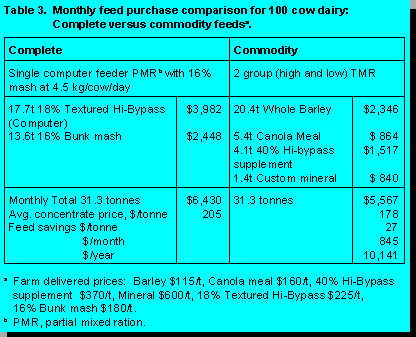
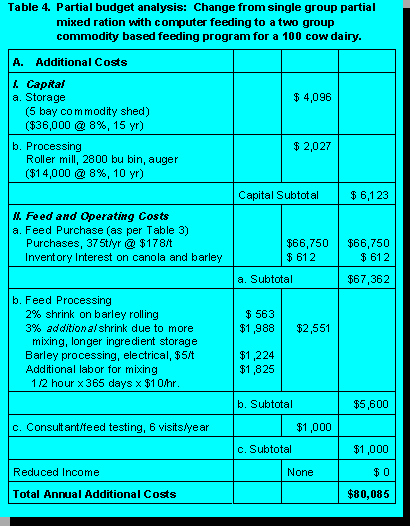
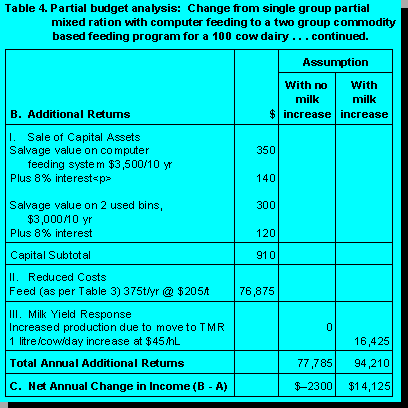
With a 200 cow dairy for the same proposed change, potential feed purchase savings amount to $20,250/year. This $50,000 venture now has a "crude" payback period of 2.5 years. Table 5 shows that the capital investment required of commodity feeding is now spread over more tonnes of feed such that the net savings/tonne increase from $-1/tonne on 100 cows to $8/tonne on 200 cows.
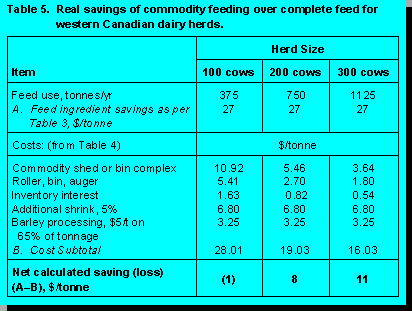
 Calculating the investment cost ($14,000,
Table 4) and shrinkage associated with processing 245 tonne of barley for a 100 cow dairy per
year shows the real cost of on-farm processed barley to be $17.04/tonne above the delivered
price:
Calculating the investment cost ($14,000,
Table 4) and shrinkage associated with processing 245 tonne of barley for a 100 cow dairy per
year shows the real cost of on-farm processed barley to be $17.04/tonne above the delivered
price:
In other words, for a 100 cow dairy, a $17/tonne premium is justifiable for steam flaked barley as this is the true cost of owning a roller mill and processing on-farm.
Storage Considerations
A commodity shed is more common than overhead storage (receiving pit, leg, distributor, bins). However, bins hold a definite advantage when it comes to shrink due to inclement weather, birds, and rodents. If processing barley on-farm, a curtain for the barley bay is advisable to reduce shrink during processing. Ensure bays or bins can accommodate 1.5 to 2 loads at a time to avoid going "empty".
Some feedstuffs flow well in an upright bin, others do not. Fuzzy cottonseed and high animal protein and/or high fat mash do not flow well. The latter, with some modification, can usually be pelleted.
In western Canada, I would suggest no fewer than five commodity bays: barley, canola meal, distillers grain or a high bypass protein blend (with or without fat), beet pulp, and one left for an opportunity feed. This bay could be used to store one ton alfalfa bales, oat hay (for dry cows), bagged feed, bedding or machinery.
Additional Points to Ponder
Buying a commercial blend of high bypass protein (may include fat) along with barley and canola meal as separate commodities does give a producer tremendous day to day ration flexibility. A ration can be adjusted for NSC, DIP or UIP quickly by simply varying the amounts of these three concentrates.
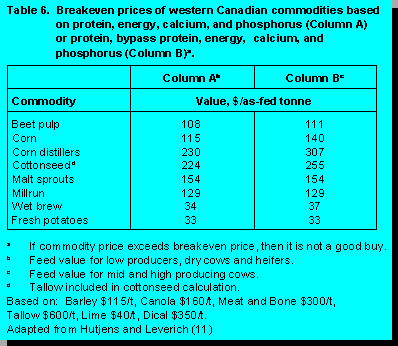 Don't purchase a commodity simply because
it's cheap. Determine what nutrients are needed, i.e. energy (NSC), DIP, UIP, then decide which
commodity or blend of commodities most economically fills the gap. For example, if bypass
protein is needed, should corn distillers grain or a blend of corn distillers, blood, meat and bone
meal be purchased? Calculate the opportunity value (Table 6) of a commodity, with an
adjustment for shrinkage.
Don't purchase a commodity simply because
it's cheap. Determine what nutrients are needed, i.e. energy (NSC), DIP, UIP, then decide which
commodity or blend of commodities most economically fills the gap. For example, if bypass
protein is needed, should corn distillers grain or a blend of corn distillers, blood, meat and bone
meal be purchased? Calculate the opportunity value (Table 6) of a commodity, with an
adjustment for shrinkage.
The opportunity value or breakeven price is the price at which a commodity becomes a "good" buy. Buying simply on price would result in an inventory of ingredients that do not supply adequate nutrients for optimum productivity.
A dairy manager who is committed to commodity feeding will tend to move away from feeding cows to the business of purchasing commodities. This means nutritional advice becomes more important. However, the less a producer purchases from a feedmill, the fewer nutritional services its personnel can provide. A producer serious about commodity feeding must be willing to pay for an outside consultant. Feed analyses costs also become the producer's responsibility. In California, this service typically costs $1/cow per visit (max of $300 to $600 depending on herd size and number of groups required to ration balance) plus feed test charges. Nutritional consultants also charge on an hourly basis with $50 to $75/hour being typical for local consultants.
Consider shelf life in relation to the quantities bought and the usage rate. Cows prefer fresh to stale feed. High moisture feeds like brew and potatoes are a special challenge because of their perishability. Typical vitamin losses in premixes and minerals are at least one to three percent per month.
Feed value can vary significantly from load to load. Routine feed analysis (at $30 to 50/sample) is necessary in order to monitor quality and make ration adjustments before problems develop. One can argue that feeds like barley and canola meal are quite consistent, but analyze to at least keep your supplier "honest". For example, is the canola meal consistently meeting the 34% minimum guarantee for CP? Has the moisture in the brewers grain changed? I have seen the protein content in brewers grain from the same supplier go from 22.5% to 30.1% (DM basis) from one load to the next. Ensure that the feed is free of molds, mycotoxins, and anti-nutritional factors (weeds, gossypl in cottonseed). Unless you are dealing with a feed company or a broker, there are no minimum guarantees on nutrients or assurances of quality. Quality control and associated costs are now your concern. Failure to have a quality control program will result in bigger costs in the future, e.g. lost production and/or reduced fertility.
Is the supply of a particular commodity feed dependable? If not, can a contingency plan be quickly implemented? Consider diet adaptation. A feed containing fat such as cottonseed, sunflower seed, or bakery waste must be introduced gradually to avoid digestive upset. Does a feedstuff have a potential benefit over and above what is currently being fed? For example, should a single source of UIP such as corn distillers be replaced with a blend of blood meal, meat and bone meal, corn gluten meal, and distillers? Would the improved post-rumen amino acid supply boost production and/or improve fertility through less severe body condition loss?
Conclusions
Acknowledgements
References